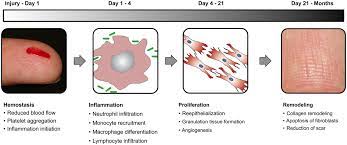Facilitate wound healing process with Biotech Peptides

Peptides are defined as the polymer formed by binding amino acid subunits. A Peptide is a molecule that is made up of two or more amino acids linked together by peptide bonds. Peptide molecule can be biologically active alone or as a subunit for a larger molecule. Proteins that are large in size are generally proteins that consist of peptide subunits. It is used in wide areas and fields including chemistry, biology and medicine preparations as they act as hormones, proteins, cells, enzymes and tissues of the body and meets up with various of the body’s needs.
Medicinal value of peptides
The medical values of peptides are high and they take an important position in the biological and medical arena. These are naturally produced in the organisms and compounds synthesized in the lab acts like this and stayed active when taken inside the body. Peptides are known to act as structural compounds of tissues and cells. It also includes antibiotics, hormones, toxins and enzymes. The hormone melittin, gluthione, oxytocin, glucagon and pancreatic hormone insulin also considered as peptides.
BPC-157
Both BPC-157 and TB-500 are known to promote wound healing though the biochemical pathways are different. Research has also shown that in combination, the two molecules exhibit synergistic effects in the whole healing process. It is a well known fact that fbroblasts and immune cells are absolutely important for the regulation and execution of successful healing of wounds. Both the fibroblasts as well as immune cells migrate to the tissue injury site where the fibroblasts encourage the extracellular matrix formation. These cell movements are reliant on the protein axin.
These peptides are known to facilitate the wound healing through the regulation of axin protein. The transcriptions of axin gene are promoted by the peptide and hence there will be an increase in the expression of the protein. It needs to be understood that TB-500 enhances the overall functionality of axin by making a connection. The axin filaments are formed as the next processes which are further required for fibroblast and immune cell migration. It is known that both BPC-157 and TB-500 blend peptides enhances the function of actin and encourage faster migration of cells to the fields that are damaged.
Know about the growth hormone
Growth hormone comes across as the main for the synergy between that of BPC-157 and TB-500 for facilitating healing of wounds. The molecules in both of these are known to interact with the growth hormone during the healing process. BPC-157 induces growth hormone receptors production on the surface of fibroblasts thus increase the lifespan of the cells to a great extent. Owing to this, the regeneration of soft tissues is stimulated. TB-500 goes on to advance the localization of actin and also filament formation. It also makes sure that the actin reserve is properly maintained for use by fibroblasts in their lifespan.
Overall, it needs to be understood that the combination of BPC-157, TBS-500, growth hormones and collagen can come across as a reliable alternate treatment regimen that aids faster wound healing to replace other treatment forms.



